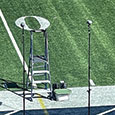Victoria Jicha’s article in the July/August 2015 issue of Flute Talk makes several important points about behavior within an organization. She states that chain of command matters and to work effectively within an organization, one must understand this. Having offended the chain in more than one instance in several types of organizations, I can vouch for the validity of her argument.
However, playing nicely with others has another connotation in music groups, from duets to orchestras. Generally, music students learn most of the principles of music etiquette when they play in band. A good beginning band director will teach students how to play nicely with others. This etiquette education continues in high school and college bands and orchestras.
The problem arises with individuals who have never played in a band or orchestra. These players have not been taught the etiquette of playing in a group, and when they try to play with a community band or flute choir, they often do not know what to do. This causes embarrassment for the individual player who has made a faux pas and aggravation for other members of the group.
We all need to remind ourselves about music group etiquette as the new year begins. Here are some recommendations based on my 64 years of playing flute and piccolo in a variety of groups.
Know your instrument
Handle it with respect and if it needs adjustment, take it to a good repair person. Ask members of your group for recommendations.
Work with a tuner to determine which pitches are problems with your particular instrument. Use a marking pen to put a line on the instrument to indicate where it is in tune to the tuning note your group uses. This gives you a consistent place to start when tuning in the group. If your flute is built to A442 and your group tunes to A440, pull out. If you are consistently sharp on a particular note (which you know from working with the tuner), mark that note in the music so you will remember to play it down. I consistently play sharp on high F# so I have to play it down; this is just how it is for me. Everyone has notes with such problems. Pitch is a random variable, and you have to do what you can to control it.
Intonation is relative
This means that while you might be in tune with the tuner, you might still be out of tune with the group. Listen and make adjustments to be in tune with the group. Pitch changes with room temperature, atmospheric pressure, and even the condition of your lips. The tuner gives an absolute pitch based on physics and does not vary with other factors. If each member of the group uses the tuner to get the tuning note pitch, then the group will be close to in tune, but remember that a tuning pitch is just a starting point. Agreement with the tuner just gets everyone in the same pitch neighborhood; use your ear to get to the right address relative to the group.
Learn your part
This may seem obvious, but there is nothing more irritating than a player who consistently practices a passage while the director is trying to explain how the group should think about that section. Rehearsal is for learning how all of the parts fit together. Practice at home. There are five aspects that you should practice at home: learning the notes, intonation, rhythm, tone quality, and interpretation. Use a metronome to help with the counting, and subdivide on difficult passages. Do not just go through the motions; engage your brain.
Be on time to rehearsal.
This means get there early to get set up and warm up, so that when it is time to begin, you are ready. This can take some time for those with several instruments. For example, I often play bass, C flute, and piccolo in a given program. Sometimes alto and contrabass are added to that mix. It can take considerable time to prepare to play all of these instruments. Do your best on this; your colleagues will appreciate your effort. If you know you will be late, let the group know so that the order of the rehearsal can be changed if needed.
Respect the director
This can be a problem in community groups; socializing is important but the minute the director takes the podium, it is time to get serious. Stop talking, pick up your instrument and be ready to play. Generally, when the director raises the baton, you should get the instrument in position to play and take a breath so you can produce a tone at the downbeat. There is another side to this. Some directors have a bad habit of raising the baton and then talking about the music. In such a case, the players sit there holding their breath while the director talks. When the director stops in the middle of a piece by lowering the baton, stop playing. It wastes everyone’s time to wait until you get the message that the group has stopped. Directors lower the baton because they want to make a point about rhythm, interpretation, intonation, or musicality. Pay attention.
Think about your part
Notice how your music fits with the rest of the part. You should know who has the melody and who is playing the harmony. If you cannot hear the person on either side of you, you may be playing too loudly. You cannot tell whether you are in tune with the group if you cannot hear the group. Balance is important, and directors manage this by asking for more or less from various players. With one group, I had to change to a piccolo that was less powerful in order to get the balance that the director was after.
This is a lot to think about. However, we can all enjoy playing as a member of the ensemble more if we are mindful of these principles.






